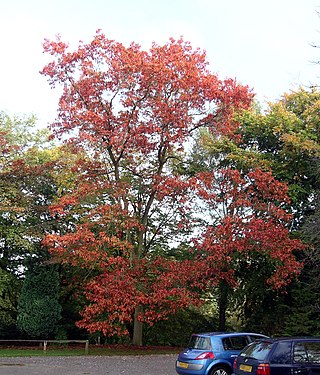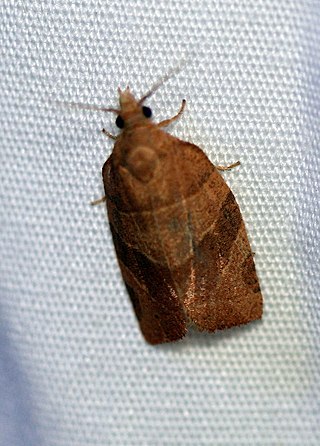
Quercus rubra, the northern red oak, is an oak tree in the red oak group. It is a native of North America, in the eastern and central United States and southeast and south-central Canada. It has been introduced to small areas in Western Europe, where it can frequently be seen cultivated in gardens and parks. It prefers good soil that is slightly acidic. Often simply called red oak, northern red oak is so named to distinguish it from southern red oak (Q. falcata), also known as the Spanish oak. Northern red oak is sometimes called champion oak.

Alnus rubra, the red alder, is a deciduous broadleaf tree native to western North America.

Ulmus rubra, the slippery elm, is a species of elm native to eastern North America. Other common names include red elm, gray elm, soft elm, moose elm, and Indian elm.

Myrica is a genus of about 35–50 species of small trees and shrubs in the family Myricaceae, order Fagales. The genus has a wide distribution, including Africa, Asia, Europe, North America, and South America, and missing only from Antarctica and Oceania. Some botanists split the genus into two genera on the basis of the catkin and fruit structure, restricting Myrica to a few species, and treating the others in Morella.

Myricaceae is a small family of dicotyledonous shrubs and small trees in the order Fagales with its type genus Myrica, the sweet gales. There are three genera in the family, although some botanists separate many species from Myrica into a fourth genus Morella. About 55 species are usually accepted in Myrica, one in Canacomyrica, and one in Comptonia.

Myrica rubra, also called yangmei, yamamomo, Chinese bayberry, red bayberry, yumberry, waxberry, or Chinese strawberry is a subtropical tree grown for its fruit.
The elm cultivar Ulmus 'Rubra' was reputedly cloned from a tree found by Vilmorin in a wood near Verrières-le-Buisson in the 1830s. It was listed in the 1869 Catalogue of Simon-Louis, Metz, France, as Ulmus campestris rubra, and by Planchon in de Candolle's Prodromus Systematis Naturalis Regni Vegetabilis (1873) as Ulmus libero-rubra: 'Orme à liber rouge' [:elm with red inner bark]. Elwes and Henry (1913) and Bean (1936) listed it as Ulmus montana [:U. glabraHuds.] var. libro-rubro, the former stating that the tree appeared "identical" to Simon-Louis's Ulmus campestris rubra. A specimen in the Zuiderpark, The Hague, was identified in 1940 as a wych elm cultivar, U. glabraHuds.libero rubro.
Waxberry is a common name for several plants and may refer to:

Plumeria rubra is a deciduous plant species belonging to the genus Plumeria. Originally native to Mexico, Central America, Colombia and Venezuela, it has been widely cultivated in subtropical and tropical climates worldwide and is a popular garden and park plant, as well as being used in temples and cemeteries. It grows as a spreading tree to 7–8 m (23–26 ft) high and wide, and is flushed with fragrant flowers of shades of pink, white and yellow over the summer and autumn.

Myrica cerifera is a small evergreen tree or large shrub native to North and Central America and the Caribbean. Its common names include southern wax myrtle, southern bayberry, candleberry, bayberry tree, and tallow shrub. It has uses in the garden and for candlemaking, as well as a medicinal plant.

Prodelphinidin is a name for the polymeric tannins composed of gallocatechin. It yields delphinidin during depolymerisation under oxidative conditions.
Lyonetia myricella is a moth in the family Lyonetiidae. It is known from Japan.

Myrica esculenta is a tree or large shrub of the tropics. The native range of this species stretches from Northern India (Uttarakhand) to Nepal to southern China and western and central Malesia. Its common names include box myrtle, bayberry and kaphal. Its berries are edible and are consumed locally.
Eudemis gyrotis is a moth of the family Tortricidae. It is found in Vietnam, India, Japan and Taiwan.

The diarylheptanoids are a class of plant secondary metabolites. Diarylheptanoids consist of two aromatic rings joined by a seven carbons chain (heptane) and having various substituents. They can be classified into linear (curcuminoids) and cyclic diarylheptanoids. The best known member is curcumin, which is isolated from turmeric and is known as food coloring E100. Some other Curcuma species, such as Curcuma comosa also produce diarylheptanoids.

Choristoneura lafauryana, the strawberry leafroller, is a species of moth of the family Tortricidae. It is found in Spain, Great Britain, the Netherlands, Belgium, France, Germany, Switzerland, Italy, Romania and Russia. In the east, the range extends to China, Korea and Japan.

Pandemis limitata, the three-lined leafroller, is a species of moth of the family Tortricidae. It is found in North America, where it has been recorded from Nova Scotia to British Columbia and from the east coast west to the Rocky Mountains and Arizona. It has also been recorded from Durango in Mexico.
Shorea rubra is a tree in the family Dipterocarpaceae, native to Borneo. The specific epithet rubra means 'red' and refers to the underside of the leaf.
Calmei is a California-based seller of Myrica rubra fruits founded in 2018.













